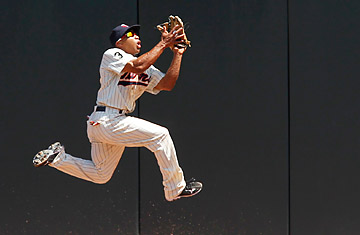
Action like this catch by Minnesota Twins center fielder Ben Revere is not likely to stop anytime soon
(2 of 2)
In addition, the pesky issue of steroid testing has mostly been resolved. For years, the union resisted testing; in 2002, the players finally agreed to a relatively weak program. But as the steroid scandal boomed, public pressure, including exhortations from Congress, compelled the players and owners to amend the agreement several times in order to create both stronger protocols and harsher penalties for offenders. Legendary baseball labor leader Marvin Miller, who helped the players win free agency back in the 1970s, is still critical of the union's decision to revise these agreements before they expired. "That's not realistic behavior for a union," Miller tells TIME. (The Major League Baseball Players Association, or MLBPA, declines to respond to Miller's comments).
From a fan's perspective, however, steroid testing is worth rooting for. At a time when almost any hitter's home-run surge is viewed suspiciously, it makes the game more credible. In this next round of bargaining, baseball will push for human-growth-hormone (HGH) testing, which the sport instituted last year in the minor leagues (on Thursday, Major League Baseball announced that Colorado Rockies farmhand Mike Jacobs, who has spent parts of six seasons in the major leagues, became the first pro baseball player to test positive for HGH). Traditional urine tests don't reliably detect HGH. A blood sample is required for this testing, and the union has called the procedure invasive. In their recent settlement with the owners, however, football players agreed to some, yet still undefined, regimen of HGH testing, which will put further pressure on baseball's players to do the same.
Although this issue will be contentious during negotiations, it's unlikely to shut down baseball. "Bargaining revisions to the testing system," says Rob Manfred, MLB's lead labor negotiator, "is much easier than installing it in the first place."
Psychology may also save baseball from labor pain. "The defining moment in the current labor negotiations is still the 1994 strike," says the sports-labor expert LeRoy. "I know it's 17 years in the past, but for many, the pain is still fresh." Bud Selig was the acting MLB commissioner back in 1994, and he has the official job today. MLBPA chief Michael Weiner replaced longtime union head Donald Fehr in 2009, but he's been with the union since 1988. The parties remember all too well the 1994 work stoppage, which canceled the World Series that year and caused attendance to drop once the shortened 1995 season resumed.
LeRoy notes that labor studies have shown that in the years, even decades, following an epic work stoppage or dispute, the parties return to what labor scholars call a "healthy bargaining protocol." Owners and workers cut down on the bluffing and listen to each other better. It makes sense: After going through one painful divorce, do you really want to go through another?
Healthy bargaining protocol may be escaping the NBA, which is experiencing another lockout just a dozen years after its last one. But the situations facing baseball and basketball are not completely analogous. That 1999 work stoppage may have delayed the start of that season. But it did not kill the postseason, nor did it cause as much national outrage and internal scarring as the '94 baseball strike.
Still, while baseball is in a better position to avoid rancor than it was in the past, the two sides won't be roasting marshmallows together over the next few months. Aside from revisions to the steroid policy, players and owners will be debating the merits of a "slotting" system, in which the amount of money teams pay draft picks depends on where players are selected. The new football CBA includes revisions to a similar system. Baseball has also talked about implementing a true international draft. Right now, only players from the U.S., Canada and Puerto Rico are eligible for the draft. As a result, salaries for teenage players from Latin America, particularly from the Dominican Republic, have escalated in a largely unregulated free-agent market. In this market, players are shopped to the highest bidder by unlicensed agents who take a 25%-50% cut of a player's signing bonus. If a bonus was determined by draft position, spending on these unproven players would presumably fall, but there would be less need for unlicensed agents to play one team against another. The elimination of the agent's role would permit the players to pocket more of their bonus for themselves.
Some plan to realign baseball's current six-division setup will also be discussed. This issue, like others facing the players and owners, seems benign. When asked for his best guess on the odds of a work stoppage, Manfred, demurs. "I don't want to put any odds on it," says the MLB labor negotiator. "But I will say that we've been very fortunate to get through the last two rounds of collective bargaining without a work stoppage. And I think the goal, on both sides, is to make it three in a row."
In a year of irritating sports-labor battles, that's the kind of winning streak fans can really cheer.
Sean Gregory is a staff writer at TIME. Keeping Score, his sports column for TIME.com, appears on Fridays. Find him on Twitter at @seanmgregory. You can also continue the discussion on TIME's Facebook page and on Twitter at @TIME.
